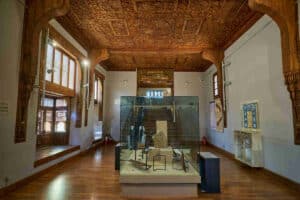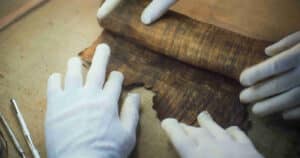The image of the Pyramids of Giza next to the waters of a river seems very suggestive and idyllic… but it is not far from reality. This has been recently reported by researchers from the University of Cambridge, who have published their study in the journal Nature. about what has been called a new branch of the Nile: Rama Ahramat. In this post we give you some clues about the finding.
Confirmation of a previous theory
The aforementioned Nature article has a very eloquent title: Found at last. That is, “Found at last”. The belief that a branch of the Nile passed through here was not exactly new, and its confirmation was already close, as we commented in a previous post of this blog.
But it is only now that it has been confirmed with modern research techniques. Specifically, satellite radar images , geophysical data and soil samples to study its composition and sediments. And with all this information, the team led by Judith Bunbury has no doubts: a few hundred meters from the Pyramids of Giza ran Rama Ahramat, the aforementioned branch of the Nile, which facilitated the transport of the large limestone blocks, extracted in quarries in the area.
Temples of the Valley, used as ports
Another of the interesting contributions of this study of the University of Cambridge is the function of the Temples of the Valley, located a few hundred meters from the Pyramids of Cheops, Chephren and Mycerinus, and connected to them by a straight line. Without denying the religious function that these sacred constructions had, it is logical to think that the land on which they were located was used as a port or unloading dock for these blocks, long before the structures of the valley temples were built.
Thus, it is possible to interpret that the long, straight roads connecting the temple and the pyramid not only carried the mummy of the corresponding pharaoh in a purification rite: it can also be interpreted that these roads were the last meters, already on the ground, of the large stone blocks that were then mounted on the pyramid in question.
And this suggests that the Giza plateau was not the only place where this system was used, for example in the necropolis of Saqqara, the Pyramid of Unis also has its own valley temple, which could have acted in a similar way.
The transportation of stone blocks, documented
As is well known, the construction of the Pyramids of Giza has given rise to many conspiracy theories, the most daring being those that speak of the hand of extraterrestrials. One of the most repeated arguments is the supposed impossibility of transporting such large blocks of stone with the technical means of that time.
But Ancient Egyptian civilization proved to be very bold in details such as these. In fact, to confirm the practice of transporting stone blocks in river boats , it is not necessary to do a lot of research, but simply to observe: there are paintings and reliefs from Ancient Egypt where this activity is represented. An example of this are those in the Egyptian Museum in Cairo, from the tomb of Ipi (dynasty VI) in Saqqara. This is what the builders of the Pyramids of Giza would have done through the arm of the Nile.
And as far as overland transportation is concerned, the hundreds of meters between the location of the temples in the Valley and the Pyramids must not have been too titanic an undertaking, considering that colossal statues of great weight could be transported over tens of kilometers, as shown by the paintings in the tomb of Dyehutihotep (XIth Dynasty), at Deir El-Barsha.




